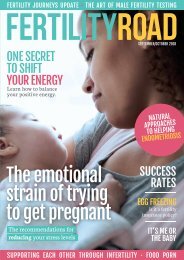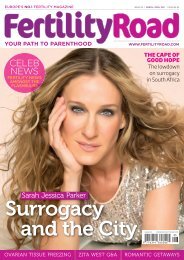Fertility Road Issue 06
You also want an ePaper? Increase the reach of your titles
YUMPU automatically turns print PDFs into web optimized ePapers that Google loves.
words | ElEna Dumitriu<br />
Travelling abroad can sometimes be<br />
overwhelming and daunting, but can<br />
still be a very worthwhile experience<br />
when seeking cutting edge fertility<br />
options and solutions.<br />
Whether you need basic in vitro fertilisation (IVF)<br />
treatment in order to conceive, or the help of an<br />
egg donor and/or surrogate mother, these services<br />
are not just available, but are also successful.<br />
Whether you are a traditional couple, a gay couple, a single<br />
woman, or a single man, everyone is given a fair chance to<br />
achieve parenthood.<br />
And by taking a more in depth look, the possibilities continue<br />
with state of the art treatment options, such as PGD (Preimplantation<br />
Genetic Diagnosis), ICSI (Intra Cytoplasmic Sperm<br />
Injection), and yes, even Gender Selection.<br />
PGD represents the beginning of an end to<br />
many genetic diseases. A single cell from a<br />
developing embryo is removed and tested<br />
for a genetic abnormality, which gives the<br />
reproductive embryologist the possibility of<br />
implanting only healthy embryos. The result<br />
will be the significant reduction and possibly<br />
the eradication of a genetic disease from<br />
affected families with such history. PGD is<br />
also considered another way to prenatal<br />
diagnosis. Its main advantage is that it avoids<br />
selective pregnancy termination as the method makes it highly<br />
likely that the baby will be free of the disease under consideration.<br />
Furthermore, PGD with IVF is an important procedure to help<br />
achieve family balancing i.e. gender selection.<br />
ICSI is most commonly used to overcome male infertility<br />
problems. ICSI is a very effective method to fertilise eggs in the<br />
IVF lab after they have been aspirated from the female. Under the<br />
microscope, a single sperm is injected and released into a mature<br />
egg. A special needle is carefully advanced through the outer shell<br />
of the egg and the egg membrane, and the sperm is injected into<br />
the inner part of the egg. After the procedure, the egg is placed<br />
into a cell culture and checked on the following day for signs of<br />
fertilisation. This usually results in normal fertilisation in about<br />
75-85% of eggs injected with sperm. Once the embryo is created<br />
it is then ready for implantation.<br />
Gender selection is the attempt to control the sex of the offspring<br />
to achieve a desired sex and it does require the use of IVF.<br />
It has also been known as family balancing, and with the help of<br />
PGD can now be determined prior to implantation of the embryo.<br />
Once the fertilised egg has reached the 8 cell embryo stage (day<br />
3), a single cell can be removed for testing. If a Y chromosome is<br />
present, this indicates that the gender of the embryo is male.<br />
This procedure has a 99% accuracy rate for gender selection,<br />
significantly higher than with sperm sorting.<br />
There has been a rising trend in the past few years of more<br />
and more international couples and individuals coming to the<br />
States seeking fertility treatments. The two main reasons for<br />
driving people overseas are medical, mostly diagnosis methods<br />
which are directly correlated with higher rates of success and<br />
treatment options, and the other one is legal, especially when an<br />
egg donor and/or surrogate mother is needed.<br />
Medically, by running a select battery of tests, composed of an<br />
ultrasound, select blood work, and often times a hysterosonogram,<br />
the reproductive endocrinologist may identify quite effortlessly<br />
what is causing the hardship in conceiving. Often times, women<br />
who have gone through several IVF cycles either in their country of<br />
residence or even abroad, come to the States only to achieve success.<br />
Legally, when the help of a third person is needed, the US makes<br />
the baby equation become possible for many couples and individuals<br />
looking to achieve parenthood. Thanks to modern science egg<br />
donation and surrogacy are relatively new options. Still keeping<br />
the hush-hush factor acquired many years ago, it does not come as<br />
a surprise that many countries do not condone them. And especially<br />
to compensate for such a service, has raised a lot of eyebrows.<br />
It is illegal to pay an egg donor and/or a surrogate mother in<br />
most parts of the world, which makes it very hard for someone to<br />
The time spent on various waiting<br />
lists for an egg donor can be years, and<br />
even when someone finally becomes<br />
available, there is very little information<br />
offered to the recipients.<br />
consider this as an option. The time spent on various waiting lists<br />
for an egg donor can be years, and even when someone finally<br />
becomes available, there is very little information offered to<br />
the recipients. No photos, or family history, age, and any pieces of<br />
the puzzle that should make this a successful and definitely more<br />
enjoyable experience.<br />
Because compensation for egg donors is allowed in the USA,<br />
the pool of donors is rather large. To be clear, the donor is not<br />
compensated for the actual eggs, but for the pain and suffering<br />
she goes while the eggs are retrieved. While in the USA egg<br />
donation is also mostly anonymous the prospective parents »<br />
www.fertilityroad.com<br />
33
















